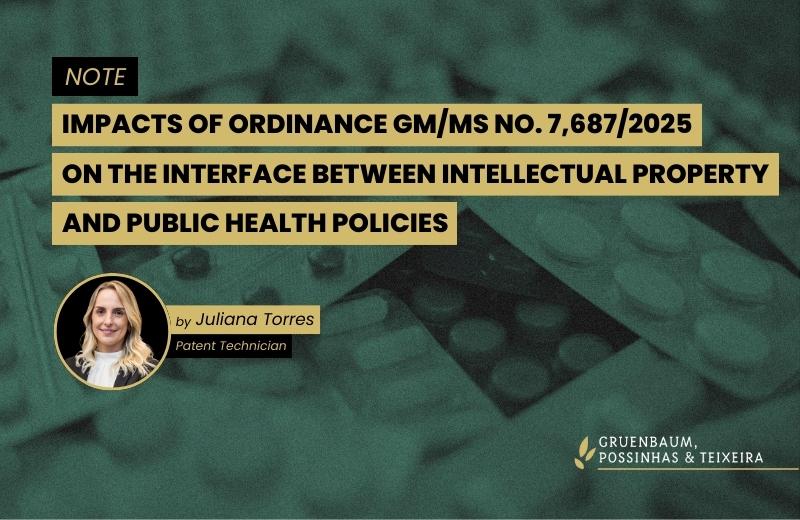Impacts of Ordinance GM/MS No. 7,687/2025 on the Interface between Intellectual Property and Public Health Policies

1. Introduction
The publication of Ordinance GM/MS No. 7,687, of July 24, 2025, in the Official Gazette of the Federal Government ((Diário Oficial da União – DOU) on July 28, 2025, introduces significant changes in the field of intellectual property (IP), particularly with regard to its interaction with public health policies in Brazil. Amendments to Chapters III and V-A of Annex XXVII of Consolidation Ordinance GM/MS No. 2/2017 strengthen the role of the Brazilian Ministry of Health in the analysis of, and influence over, patent applications that may impact the Brazilian Unified Health System (Sistema Único de Saúde – SUS).
2. Expansion of ANVISA’s Role
One of the most significant changes brought by the new Ordinance is the expansion of the scope of Brazilian Health Regulatory Agency (Agência Nacional de Vigilância Sanitária – ANVISA) responsibilities. From now on, medical devices are included among the technologies that may be subject to a public technical opinion issued by ANVISA at the request of the Ministry of Health.
Previously, this mechanism was primarily focused on medicines. Under the new regulation, any pharmaceutical product, process, or medical device that is subject to litigation for access purposes may be examined by the regulatory agency regarding its patentability. This measure strengthens state oversight and enables faster and more coordinated responses to judicial disputes concerning technologies essential to SUS.
3. Strengthening of GAPIS
The Ordinance also enhances the structure and functions of the Intellectual Property and Health Coordination Group (GAPIS). With the express inclusion of medical devices within the group’s scope, and clearer definitions regarding its composition and operation, GAPIS is consolidated as a strategic body for:
- – Identifying patent applications relevant to pharmaceutical policies and pharmaceutical assistance;
- – Conducting technical assessments of health and economic impacts;
- – Promoting political coordination within the Health Economic-Industrial Complex (Complexo Econômico-Industrial da Saúde – CEIS).
These changes reinforce the institutional capacity of the Ministry of Health to align patent policy with the national health and innovation strategy.
4. Restructuring of COMPIS
The Commission on Intellectual Property in Health (COMPIS) also undergoes significant reform. The new composition of the Commission includes representatives from CEIS and from the Secretariat for Information and Digital Health, aiming to integrate different technical and strategic areas of the Ministry of Health.
The changes are intended to:
- – Expand the technical and political capacity of COMPIS;
- – Ensure coherence with SUS priorities;
- – Reinforce the National Medicines Policy;
- – Support the development of an IP policy focused on collective interest.
5. Main Impacts on the Patent Sector
The changes introduced by Ordinance GM/MS No. 7,687/2025 are expected to have direct effects on the examination and processing of patent applications, especially those involving high-impact technologies for SUS. The main anticipated impacts include:
- – Delays in the processing of applications when ANVISA consultative opinions are requested;
- – Increased technical scrutiny in examinations, which may raise the rate of patent refusals;
- – Facilitation of compulsory licensing strategies, with greater predictability and prior monitoring;
- – Reduction of weak applications or abusive filings, in view of strengthened oversight.
6. Final Considerations
Ordinance GM/MS No. 7,687/2025 reaffirms Brazil’s position in defense of a balanced patent system, one that recognizes both the importance of innovation and the guarantee of the right to health. The changes strengthen institutional mechanisms for the evaluation and control of patent applications with health impacts and establish the Ministry of Health as an active player in the field of intellectual property, guided by the protection of the public interest.
These developments should be closely monitored by:
- – Intellectual property professionals;
- – Pharmaceutical and medical device industries;
- – Universities and research centers.
In addition to requiring more technical and consistent protection strategies, these changes will directly influence the regulatory and legal dynamics of health and biotechnology in the country. Despite the increased complexity of the processes, the outlook points to greater predictability and institutional security, provided there is clear regulation and continuous dialogue between the public and private sectors.
